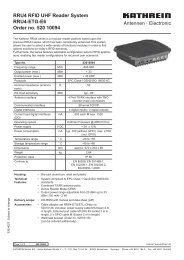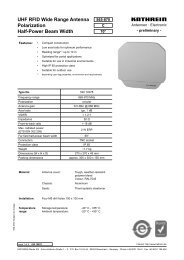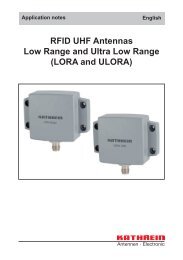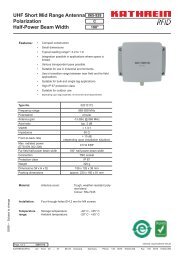Basic Antenna Principles for Mobile Communications
Basic Antenna Principles for Mobile Communications
Basic Antenna Principles for Mobile Communications
Create successful ePaper yourself
Turn your PDF publications into a flip-book with our unique Google optimized e-Paper software.
The transmitting antenna is mounted higher and in the middle in order to guarantee a cleaner omnidirectional<br />
characteristic. Furthermore the influence of the Rx and Tx antennas on each other is reduced<br />
(higher isolation). The two receiving antennas are spaced at 12-20 λ to achieve a diversity gain of<br />
4-6 dB.<br />
5.1.1.2 Sectored Base Station<br />
Omni base stations are mainly installed in regions with a relatively low number of subscribers. For<br />
capacity reasons the communications cell is divided into 3 sectors of 120° in urban areas. Directional<br />
antennas, <strong>for</strong> example panels, are used to cover these sectors. All 3 antennas per sector can be mounted<br />
at the same height because directional antennas have higher isolation in comparison to omnidirectional<br />
antennas.<br />
5.1.2 Polarization Diversity<br />
The reflections which take place within urban areas are not all of the same polarization, ie. horizontal<br />
components also exist. Furthermore a mobile telephone is never held exactly upright which means that<br />
all polarizations between vertical and horizontal are possible. It is there<strong>for</strong>e logical that these signals be<br />
also used. Space diversity uses 2 vertically polarized antennas as reception antennas and compares<br />
the signal level. Polarization diversity uses 2 orthogonally polarized antennas and compares the resulting<br />
signals.<br />
5.1.2.1 Horizontal and Vertical Polarization<br />
The dipoles of both antenna systems are horizontally and vertically polarized respectively.<br />
A spacial separation is not necessary which means that the differently polarized dipoles can be mounted<br />
in a common housing. Sufficient isolation can be achieved even if the dipoles are interlocked into<br />
one unit so that the dimensions of a dual-polarized antenna are not greater than that of a normal polarized<br />
antenna.<br />
As a result there are the following advantages:<br />
– 2 antennas only are now needed per sector: 1 x hor./vert. <strong>for</strong> polarization diversity<br />
1 x vert. <strong>for</strong> Tx<br />
(Figure 20)<br />
– A minimum horizontal spacing is only required between the antennas, the antennas<br />
can also be mounted one above the other on the same mast. This makes the complete sector<br />
very compact, thereby easing permission procedures.<br />
– 11 –

















